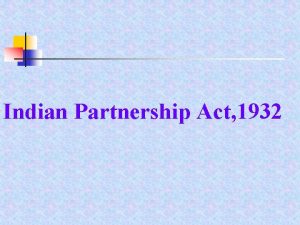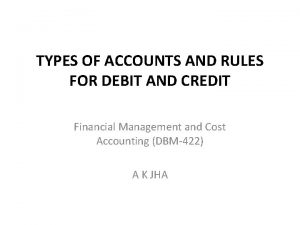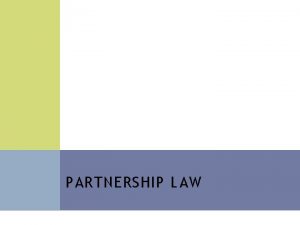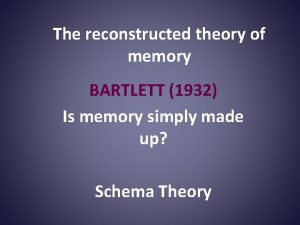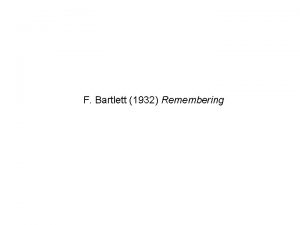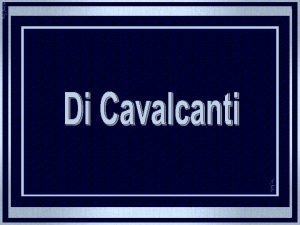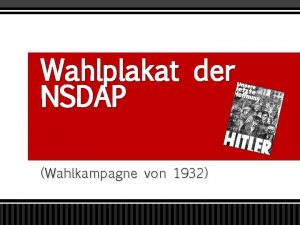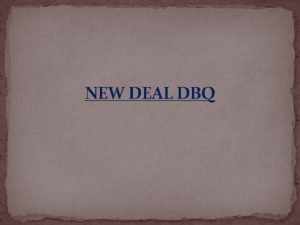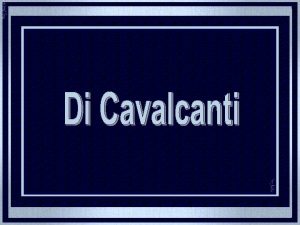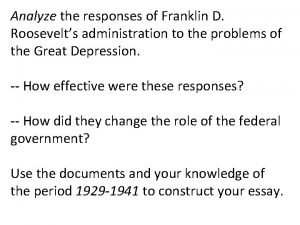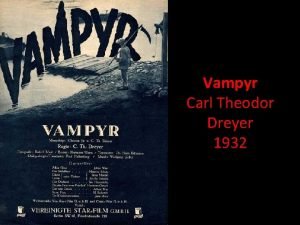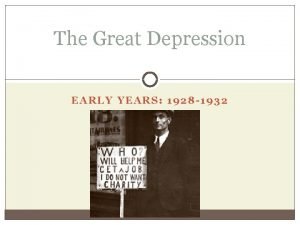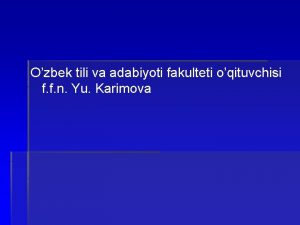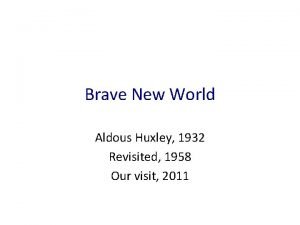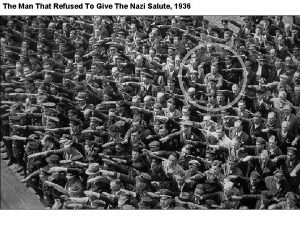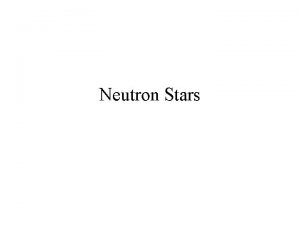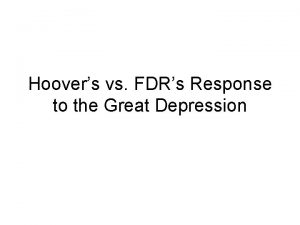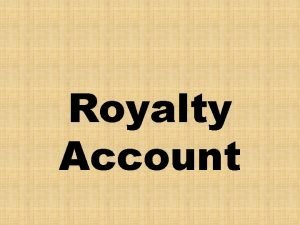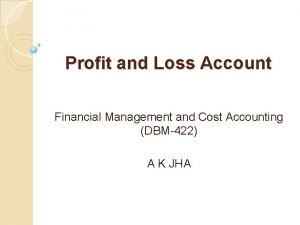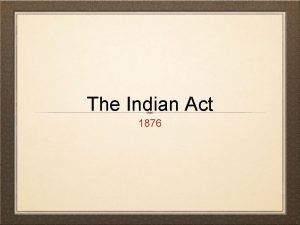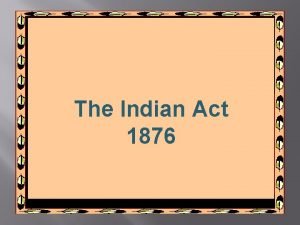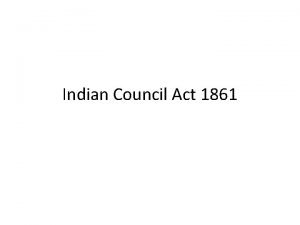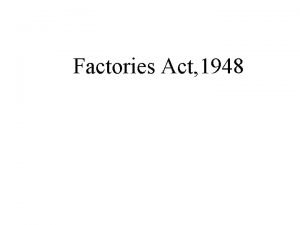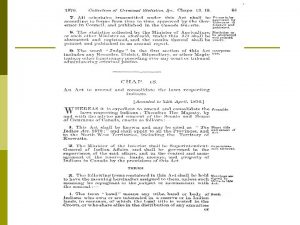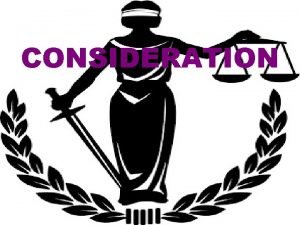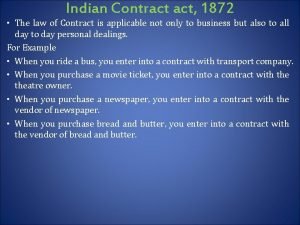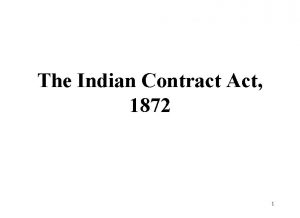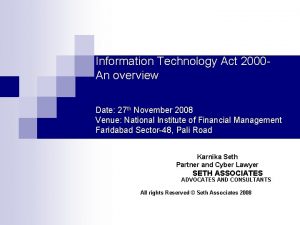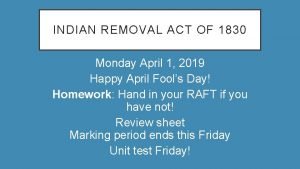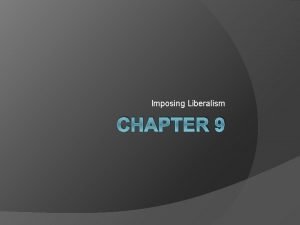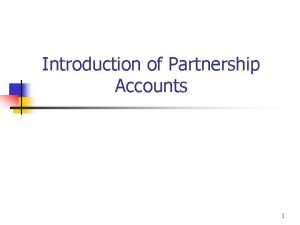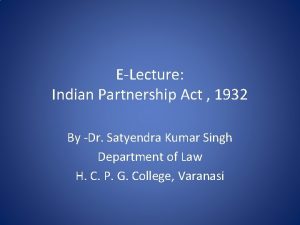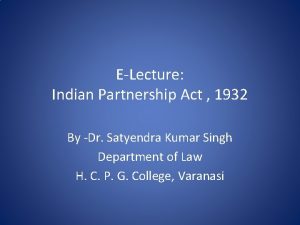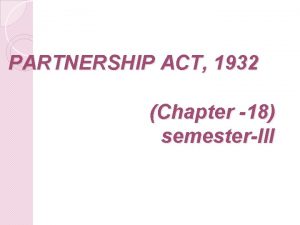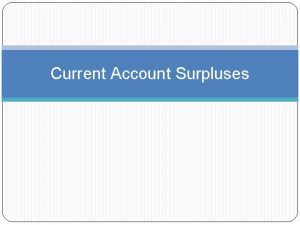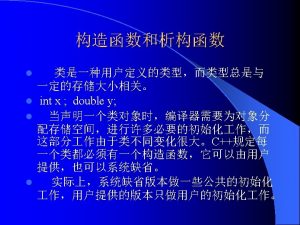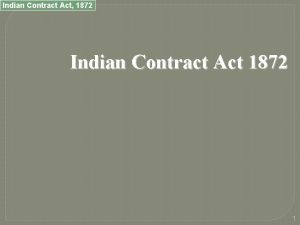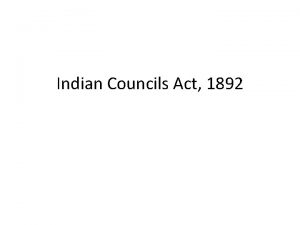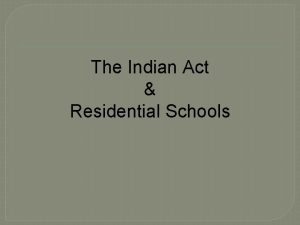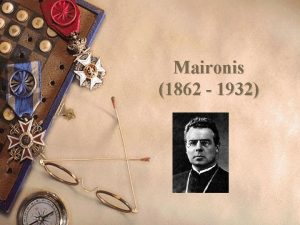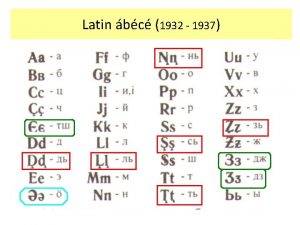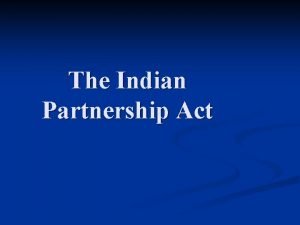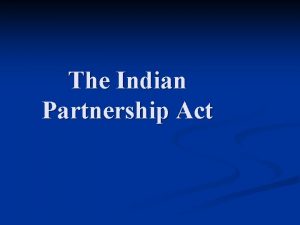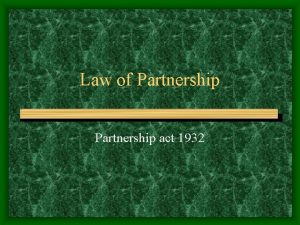Partnership Account Introduction The Indian Partnership act 1932

















































































- Slides: 81

Partnership Account Introduction: The Indian Partnership act 1932 recognizes the difference between the dissolution of partnership and dissolution of firm Acc. To section 39 of Indian Partnership Act 1932 the dissolution of partnership between all the partners of a firm is called the dissolution of firm Dissolution of partnership means reconstitution of the firm due to retirement, insolvency and death of a partner.

DISSOLUTION The term ‘dissolution’ means discontinuation or termination of partnership agreement. The Indian Partnership Act, 1932 recognizes the difference between ‘Dissolution of partnership’ and ‘Dissolution of firm’. On Dissolution of firm, the firm’s assets are realized and the liabilities are discharged because the firm is to be closed, where as on Dissolution of partnership, the share of the outgoing partner is ascertained and the firm is not closed.

Difference between dissolution of partnership and dissolution of firm The assets and liabilities are discharged in case of dissolution of firm whereas the share of out going partner is ascertained and the firm is not closed in case of dissolution of partnership

MODES OF DISSOLUTION OF FIRM Section 40 to 44 of the Indian Partnership Act, 1932 deal with the various ways in which a firm may be dissolved. A firm may be dissolved in any of the following ways: Dissolution by Agreement Dissolution on the happening of contingencies Dissolution by notice of partnership at will Dissolution by operation of law Dissolution by court.

Dissolution by Agreement A firm is dissolved when all the partners agree that it should be dissolved. A partnership firm is the creation of agreement, similarly it can be dissolved by an agreement.

• Dissolution by happening of contingencies Firm can be dissolved by any of the following points unless there is a contract between the partners: v By expiry of the term of duration of the firm. v By completion of the venture for which the firm was constituted. v By the death of partner v By the adjudication of partner as insolvent

• Dissolution by notice of partnership at will When the partnership is at will then the firm can dissolved at any time by any partner giving notice in writing to all the other partners of his intension to dissolve the firm.

• Dissolution by operation of law A firm is compulsorily dissolved by the following ways: When all the partners except one becomes insolvent. When all the partners become insolvent. When the business becomes illegal. When the number of partners exceed twenty in case of ordinary business or ten in case of banking business.

• Dissolution by court At the suit of partner a court may order the dissolution of firm in any of the following ways: When a partner becomes of unsound mind. When a partner suffers from permanent incapacity and becomes incapable of performing the duties. When a partner is guilty of misconduct affecting the business of firm. When a partner has transferred whole of his interest in the firm to a third party.

Settlement of accounts on dissolution � On dissolution of firm the assets of the firm are sold and the amt. should be use in following order � Payment of realization expenses � Payment of outside liabilities of the firm � Repayment of partner’s loan � Payment of capital accounts of the partner

Difference between Firms Debt and Private Debt Basis Firms debt Private debts Incurrence of debts Incurred by firm By a partner in his individual capacity Liability of partner Use of private property All partner are liable Only excess of partner private property over his private debts can be used Only concerned partner Private property should be used first

Entries on dissolution 1. For closing assets of accounts: accounts Realisation a/c To assets a/c (individually) (being transfer of assets to realisation a/c) Dr. 2. For provision and reserve Provision for doubtful debt/ discount/ depreciation a/c Investment fluctuation fund a/c Dr. To realisation a/c (being transferred of provision and reserve to realisation a/c) 3. For closing liabilities accounts: Creditors a/c Bills payable a/c Loan a/c To realisation a/c (being transfer of liabilities to third parties) 4. For realisation of assets Cash a/c To realisation a/c (being assets are sold) Partners capital a/c To realisation a/c (being assets taken by partners) Dr. Dr. ‘OR’ Dr.

5. For payment of liabilities and expenses of realisation Realisation a/c To cash/bank a/c (being the expenses and liabilities paid) 6. For closing realisation a/c Dr. Realisation a/c To partner capital a/c (being profit transferred to partner capital a/c) Dr. 7. Payment of partner loan Partner loan a/c To cash/bank a/c (being the payment made) Dr. 8. For closing of current and capital a/c Partners current a/c /cash or bank a/c To partner capital a/c (being the amt due from partners received or credit balances) Dr.

Treatment of goodwill and unrecorded assets and liabilities Goodwill No special treatment or treated as other assets if it is already given If doesn’t appear in the books then Cash a/c Dr. To realisation a/c (being the amt. realise for goodwill) O 1. 2. O Unrecorded assets Cash a/c To realisation a/c (being income credited to realisation a/c) Unrecorded liabilities Realisation a/c To cash a/c (being payment of Unrecorded liabilities) O Dr.

P , Q, R are partners sharing profits and losses equally. On 31 st march 2012, their balance sheet stood as follow: liabilities amt Bills payable 16000 creditors 119000 Loan from Q General reserve 25000 30000 Stock Furniture 290000 40000 p’s current a/c 15000 machinery 120000 Q’s current a/c 15000 R’s current a/c 30000 P’s capital a/c Q’s capital a/c 200000 100000 R’s capital a/c 100000 620000 Assets Debtors Cash in hand Amt 15000 125000 620000

�The firm was dissolved on the above mentioned date. p agreed to pay creditors at par. Q took over the entire furniture for RS 36000. The remaining assets were sold for RS 55300. bills payable were retired at a discount of RS 100 received for payment before the due date of maturity. Expenses of dissolution amounted to RS 1200. Prepare important ledger a/c and cash book. Current a/c may be prepared in columnar form.

Solution: Realisation account amt To debtors a/c 125000 By bills payable 16000 To stock a/c 290000 By creditors a/c 119000 To furniture a/c 40000 By q’s current a/c( furniture) 36000 To machinery a/c 120000 By bank( debtors, stock, and machinery sold) 553000 To p’s current a/c [creditors] 119000 To bank [bills payable 1600100] 15900 To bank [expenses] 1200 To profit transferred to current a/c p : 4300 Q : 4300 R : 4300 12900 724000

CURRENT ACCOUNTS P TO BAL b/d - To realisation a/c To p’s capital Q R 30000 36000 1483 00 P Q By balance 15000 c/d 15000 By general 10000 reserve 10000 By 4300 realisation (profit) a/c 4300 By Q’s capital 6700 By realisation (creditors) 119000 By R’s capital 1483 00 36000 30000 R 15700 148300 36000 30000

CAPITAL ACCOUNTS P To Q’s current a/c Q 6700 To R’s current a/c To bank a/c R 15700 348300 93300 84300 348300 100000 P Q R By bal. b/d 200000 100000 By P’s current a/c 148300 100000 348300

BANK ACCOUNT TO bal b/d 15000 To realisation a/c 553000 (assets realised) By realisation a/c 15900 (bills payable) By realisation a/c 12000 (expenses) By Q’s loan a/c 25000 By capital a/c P: Q: R: 348300 93300 84300

To find out missing figure � Practical problem: the partnership b/w ram and Mohan was dissolve on 31 st march 2012. On that date the respective credits to the Capitals were Ram 50000 and Mohan 3000, Rs. 10000 were owned by the firm to Ram and Rs. 15000 were due to trade creditors. the assets represented by the above stated net liabilities realised Rs. 90000 exclusive of Rs. Owned by Mohan. Trade creditors will be settled at book figure. In addition, one bill for Rs. 1000 under discount was dishonoured and had to be taken up by the firm. The expenses of realisation came to Rs. 1200. Prepare all the necessary ledger account to close the books of the firm.

Solution: MEMORENDUM BALANCE SHEET OF RAM AND MOHAN As at 31 -3 -2012 Liabilities Amt. Assets Amt. Ram’s loan a/c Ram’s capital a/c 20000 Mohan’s loan 10000 a/c 15000 Sundry Assets 105000 (bal b/d) 50000 Mohan’s capitals a/c 30000 Trade creditors 115000

Ledger accounts Realisation a/c To sundry assets a/c 105000 By Trade creditors a/c 15000 To Bank a/c (Trade creditors) 15000 By bank a/c (Assets realised) 90000 To bank a/c (bill dishonoured) 1000 By loss on realisation transferred to capitals: Ram 8600 17200 Mohan 8600 To Bank a/c (Realisation expenses) 1200 122200

CAPITAL ACCOUNTS RAM TO Mohan’s loan a/c (transfer) MOHAN 10000 To realisation a/c(loss) 8600 To bank a/c 41400 11400 50000 30000 By bal. b/d RAM MOHAN 50000 30000

BANK ACCOUNT To realisation a/c (assets realised) 90000 By realisation a/c (trade creditors) 15000 By realisation a/c (Dishonoured bill) 1000 By realisation a/c (realisation expenses) 1200 By Ram’s loan a/c 20000 By Ram’s Capital a/c 41400 By Mohan’s Capital a/c 11400

INSOLVENCY If a partner’s capital account shows a debit balance on the dissolution of firm, he is to pay the debit balance to the fir to settle this account. But if such a partner is insolvent then his deficiency which he is not able to bring will be borne by other insolvent partners, according to a case Garner vs. Murray

INSOLVENCY OF A PARTNER – GARNER Vs. MURRAY If a partner’s capital a/c shows a debit balance on the dissolution of the firm, he is to pay the debit balance to the firm to settle this account. but if such a partner is insolvent , then his deficiency which he is not able to bring will be born by the other solvent partners in accordance with the decision in Garner vs. Murray. It states that in the absence of any agreement to the contrary , the deficiency of an insolvent partner’s capital account will be born by the other solvent partners in proportion to their capital which stood before the dissolution of the firm. The loss on account of insolvency of a partner is a capital loss and should be born by the other solvent partners in proportion to their capital. Another ruling in Garner vs. Murray case is that the solvent partner should bring in cash equal to their share of loss on realisation. But if a solvent partner has a nil balance or a debit balance in capital a/c , he will not bear such deficiency of the insolvent partner.

Applicability Garner VS. Murray In the absence of any specific provision in the Indian Partnership Act 1932 and any decision of court in India, it is a common practice to seek guidance from the English law. Therefore, it has become a practice in India to follow the decision in the Garner VS. Murray case in the absence of any specific agreement between the partners with regard to sharing the deficiency of an insolvent partner.

FIXED AND FLUCTUATING CAPITAL � If the capitals are fixed: then no adjustment is required for accumulated profits, losses , interest on capital, drawings etc. the deficiency of the insolvent partner should be transfer to the current a/c of the solvent partner in proportioned to their fixed capital Solvent partners current a/c Dr. to insolvent partner capital a/c (being transfer of deficiency of the insolvent partner to the solvent partners capital a/c) � if capitals are fluctuating: Capitals a/c should be adjusted profits, losses , interest on capital, drawings , unrecorded assets and the liabilities on the date of balance sheet just before the dissolution of the firm. It should be remembered that loss on realisation is not to be taken into consideration while ascertaining the capital ratio of the insolvent partner. Solvent partners current a/c Dr. to insolvent partner capital a/c (Being transfer of deficiency of the insolvent partner to the solvent partners capital a/c)

PRACTICAL PROBLEM (INSOLVENCY) Bini, Mini , & Tini are partners sharing profit and losses in the ratio 4: 3: 2. their balance sheet as on 31 st march 2012 as follow liabilities amt assets amt creditors 20000 Cash 2000 Bank overdraft 15000 Debtors less provision Loan (secured against machinery) 25000 stock 25000 Capitals: Bini: Mini: Tini: 33000 Machinery 40000 Profit& loss a/c 9000 18000 17000 20000 10000 3000 93000 The firm was dissolved. Stock was taken by banker and it realised Rs. 20000. bank paid back Rs. 4000 after recovering its overdraft and interest due thereon. Machinery was disposed off for Rs. 24000 and debtors realised Rs. 14000. loan was fully paid off with interest due Rs. 1000 there was an unrecorded assets Rs. 5000 was taken over by creditors at Rs. 2000. Bini paid expenses amounted Rs. 300. Tini became insolvent. Tini’s pvt. Liabilities Rs. 1000 while his estates realised Rs. 1950

Realisation account Particulars To debtor 18000 By creditors 20000 To stock 25000 By bank o/d 15000 To machinery 40000 By loan 25000 To cash: Loan paid(25000+1000) 26000 Creditors(20000 -2000) 18000 44000 by cash: Surplus from stock Machinery Debtors 42000 To Bini’s capital (for realisation expeses) 300 127300 4000 24000 14000 By provision for baddebts 1000 By loss transferred to capitals a/c Bini: 10800 Mini: 8100 Tini: 5400 24300 127300

Capital’s account bini mini tini To p/l a/c 4000 3000 2000 To realisation a/c (loss) 10800 8100 5400 To tini’s capital a/c 2400 To cash a/c 13900 31100 bini mini tini By bal b/d 20000 10000 3000 By cash a/c 10800 8100 950 1050 By realisation a/c 300 5950 by bini’s capital a/c 2400 By mini’s capital a/c 1050 18100 7400 31100 18100 7400

Cash accounts To bal b/d 2000 By realisation a/c 44000 To realization a/c 42000 By bini’s capital a/c 13900 To bini capital a/c 10800 By mini’s capital a/c 5950 To tini’s capital a/c 8100 To mini, s capital a/c 950 63850

WHEN ALL PARTNERS ARE INSOLVENT There are two ways for closing books Where outside liabilities are not transferred to realisation a/c Following procedure is followed 1. Sundry assets except cash &bank balance are transferred to debit side of realisation a/c 2. For realisation expenses , realisation a/c is debited & cash a/c is credited If any liability is secured , then liability will be paid on priority basis to the extent of realisation of the assets kept as a security Amount brought by any partner from his pvt. Estate is credited to his capital a/c & debited to cash a/c. Assets a/c is prepared in order to calculate amt. available for payment to unsecured liabilities. Capital a/c are closed by trasnferring their balances to their deficiency a/c, if prepared , will tally 3. 4. 6 7 8

WHEN ALL PARTNERS ARE INSOLVENT If the effect of realisation of all assets and liabilities is to be passed through realisation a/c In this case outside liabilities are also transferred to realisation a/c. outside liabilities are paid with the amt. available for unsecured outside liabilities which can be ascertained by preparing cash a/c. secured creditors are always paid on priority basis as compared to unsecured creditors. The realisation loss is transferred to capital a/c. The balances in capital a/c are transferred to deficiency a/c , when prepared , will tally.

PIEACEMEAL DISTRINUTION It is universally accepted practice that an interim distribution is made to the partners for their claim(after paying to all the creditors) as and when cash is available. Under such a case when there is gradual realisation of assets, it is necessary to avoid the unpleasant consequences of a partner’s account being overdrawn distributing cash of various realisations of assets in such a way that the final unpaid balance of the capital of each partner is left in his profit sharing ratio.

PRIORITY OF DISTRIBUTION On the gradual realisation of assets, the cash realised is distributed in the following order to avoid excess payment to any partner: v Expenses of realisation are to be paid in the first instance as these get preference over unsecured creditors. v Then the debts of the firm to the third parties must be paid out in full prior to any partner being paid any amount in respect of his loan and capital.

v v v Secure creditors should get preference over unsecured creditor. But their preference is subject the realisation of asset kept with them as security, otherwise they are to be treated like unsecured creditors. After the creditors have been paid off, the amount due to a partner as loan should be paid. When the loans are due to more than one partner, the cash available should be paid rateably. After the payment of outside liabilities and loans due to the partners, the capitals of the partners are paid. Partners’ capitals consist of balance in capital and current accounts and share in the undistributed profits or loss and reserves.

METHODS OF DISTRIBUTION OF CASH There are two types of methods of distribution of cash among partners in case of piecemeal distribution: Proportionate Capitol Method Maximum Loss Method

PROPORTIONATE CAPITAL METHOD If the capitals of partners are in ratio of their profit sharing arrangement, then each of them is paid out according to his capital ratio at each distribution. If the capitals of partners are in profit sharing ratio, the first cash available for distribution among partners should be paid to those partners whose capitals are more than their profit sharing ratio to bring their capitals to their profit sharing levels. Unpaid balances of capital accounts will represent loss on the realisation and this loss will be dividend in profit and loss sharing ratio of the partners.

MAXIMUM LOSS METHOD It is an alternative method for piecemeal distribution amongst partners is to calculate the maximum possible loss on every realisation after the outside liabilities and the partner’s loans have been paid. The amount available or distribution amongst partner is compared with the total amount of capitals payable to the partners and the maximum possible loss is ascertained on the assumption that in future assets will not realise any amount. But if partner’s share of maximum loss is more than the amount standing in credit of his capital account, he should be treated as insolvent and his deficiency should be debited to the capital accounts of the other partners as it is stated in the case if Garner VS. Murray.

Following is the balance sheet as on 31 st mar 2010 of a firm having three partner Alfa, Beta, Gama sharing p/l equally liabilities amount assets amount Sundry creditor Loan (secured by furniture) Capital account Alfa Beta Gama 20000 10000 Cash Stock Debtors Furniture Profit & loss a/c 3120 15630 4720 9530 12000 8000 6000 1000 45000 The firm was dissolved due to insolvency of all partners. Stock was sold for Rs. 9900 while furniture fetched Rs. 5000. Rs. 4100 were received from debtors. Realisation expenses Rs. 220. nothing could be recovered from beta and gama , but 600 could be recover from alfa private estate.

Realisation account Particulars To Sundry assets To Stock To Debtor To Furniture To Cash (realisation expenses) Amount 15630 4720 9530 220 30100 Particular Amoun t By cash : 19000 Furniture 5000 Stock 9900 Debtor 4100 By loss trd. To capital’s account: 11100 Alfa 3700 Beta 3700 Gama 3700 30100

Cash account Particular Amount To balance b/d To realisation a/c To Alfa’s capital a/c 3120 19000 600 By realisation a/c (expenses) By loan a/c (upto realisable value of furniture) By sundry liability a/c 220 22720 5000 17500 22720

Sundry liabilities account particulars amounts Particulars amount Cash a/c (70% paid) To deficiency a/c 17500 25000 By loan a/c By sundry a/c 5000 20000 25000

particular To realisation a/c To profit &loss a/c To deficiency a/c capital accounts Alfa beta Gam a particular Alfa Beta Gama 3700 8000 6000 1000 4000 By balancing a/c By cash By deficiency 900 - 1700 6700 8600 7700 600 8600

Deficiency account particulars amount s particulars To beta’s capital a/c To Gama ’s capital a/c 1700 6700 By sundry 7500 liabilities By Alfa's capital 900 a/c 8400 amount

If the effect of realisation of all assets and liabilities is to be passed trough realisation account Ques: A, B, C are three partners sharing profit &loss in the ratio of 2: 2: 1. below is the balance sheet when the firm was dissol. Liabilities ved: Amoun Assets Amount Sundry creditors A’s capital a/c B’s capital a/c A’s loan t Plant& 150000 machinery Land & building 40000 furniture 20000 Sundry debtors 20000 Cash p/l a/c c, ’s capital a/c 230000 stock 48000 40000 20000 4000 50000 10000 56000 230000

The assets realised as follow : plant &machinery Rs 20000 land & building Rs 35000; furntiure. Rs 500; sundry debtors. Rs 9500 and stock Rs 31000. the position of partners was as follow: private estate private liabilities A 16000 12000 C 10000 13000 B was able to pay 25 paisa in the rupee of what was payable on his account to the firm. the realisation expenses were amounted to Rs 1000. Prepare necessary ledger account making payment through realisation a/c

Solution: Realisation accounts particulars amount particulars Amount To plant and machinery To land & building To furniture To debtors To stock To cash (realisation expenses) To cash(creditors) 48000 By sundry creditors By cash(assets realised) By loss on realisation trd. To capital’s a/c A-2/5 share 10667 B-2/5 share 10667 C -2/5 share 5333 150000 40000 20000 56000 105667 272667 96000 26667 272667

Cash account: Particulars To bal b/d To realisation a/c(assets realised) To a’s capital a/c To b’s capital a/c Amount 4000 96000 4000 2667 106667 Particulars By realisation a/c(expenses) By realisation a/c(creditors) Amount 1000 105667 106667

Capital account: Particular To bal b/d To realisation a/c To p/l a/c To deficiency a/c A B 10667 C 10000 5333 20000 33333 20000 10000 64000 30667 25333 Particular By bal b/d By a’s loan a/c By cash a/c By deficiency a/c A 40000 20000 4000 B 20000 C 2667 8000 25333 64000 30667 25333

Deficiency account: Particulars To b’s capital a/c To c’s capital a/c Amount 8000 25333 33333 Particulars Amount By a’s capital a/c 33333

Working note: 1) Amt. brought in by B has been determined as a follow: Let ¼ of the amount due from B: Amt available to creditors after realisation of assets: cash in hand on dissolution: 4000 Add: assets realised 96000 Less: realisation expenses 1000 Add: cash realised from a’s private estate: 4000 Add: cash brought in by B. ’s estate : X Cash available for payment to creditors: 103000+X After making payment of cash available to creditors. realisation a/c will be appear as follow:

Realisation account: Particulars Plant & machinery Land & building Furniture Debtors Stock Cash( realisation expenses) Cash(creditors)l Amount 48000 40000 20000 56000 103000 + X Particulars By sundry creditors By cash (assets realised) Amount 150000 96000

Cont…. . Loss on realisation =total of debit side-total of credit side. =270000+x-246000 = 24000+x b’s share of loss on realisation is 2/5 I. e. 2/5 (24000+x)=9600+2/5 x B’s capital a/c after transferring loss on realisation will appear as follow: To p/l a/c 20000 By bal b/d 20000 To realisation a/c (loss) 9600+2/5 Amt. due from b=29600+2/5 x-20000=9600+2/5 x we supposed amt bought by b=1/4 4 x=9600+2/5 x = 2667

Conversion of a Partnership into limited company or sale of a company � Meaning: conversion of partnership means changing the status of the partnership firm into a joint stock company. A new company is formed to take over the business of the firm. This process will result in dissolution of partnership firm. The partner of the firm will become the shareholder of the company as they are alloted share by the company for taking over the business. � Need for conversion of partnership into company: the object of such conversion is to take some advantages of joint stock company over partnership firm. Such advantages are: 1. Liabilities of the shareholder will become limited. 2. The company can collect more fund for expansion of its business. 3. The entity of a company will be separated from its member. 4. To take advantage of less rate of income tax. 5. To enjoy the benefit of large scale production.

Purchase consideration It is the amount paid by the purchasing company to the vendor of the firm for taking over its assets and liabilities. The amount of it may be paid by in any form as shares, debentures of the company or cash. It is very important as it affect accounting entries in the book. Methods of calculation of purchase consideration: 1. Lumpsum method. When a fixed amount is given by the purchasing company to the vendor firm, it is called lumpsum method of purchase consideration. For example, X co. Ltd. Paid Rs. 200000 to M/s AB& Co. for purchase of business, it is a case of lumpsum method of purchase consideration. 2. Net payment method. Under this method, the purchase consideration is the amount made by the company to the vendor firm in the form of shares, debentures and cash. For example, X Co. Ltd. Is formed to take over all the business assets and liabilities for Rs. 200000 which is to be paid by the allotment of 12000 shares of 10 each fully paid and balance in cash. It is not necessary that company should take all the assets and liabilities of the firm. 3. Net assets method. under this method the total of all the assets taken over by the company at agreed value is calculated and the agreed value of the liabilities assumed is deducted. The balance is purchase consideration i. e. Purchase consideration = Agreed value of the assets taken over – Agreed value of the liabilities assumed. For example: took over the following assets at the value mentioned against them: Building Rs. 600000; Stock Rs. 300000; Debtors Rs. 400000; Goodwill Rs. 200000. The company agreed to pay to the creditors Rs. 500000. the purchase consideration will be calculated as under: Agreed value of the assets taken over Rs. Building 600000 Stock 300000 Debtors 400000 Goodwill 200000 1500000 Less: agreed value of the creditors assumed 500000 Purchase consideration 1000000

� Treatment of assets not taken over. If the assets are not taken by the company , then such assets are not transferred to Realisation Account and are disposed off by the partnership firm and entry is Cash/Bank a/c Dr. to relevant assets a/c (being assets not taken over by the company disposed off by the firm) � Treatment of the liabilities not taken over. If the liabilities are not taken by the company , then such assets are not transferred to Realisation Account but should be paid off separately. The entry is Liabilities a/c Dr. To cash/bank a/c (being payment of the liabilities not taken over by the purchasing company) � Treatment of purchasing consideration from the purchasing company. The journal entry is: Purchasing company a/c Dr. To realisation a/c (being the amount of purchase consideration agreed to be paid by the purchasing company) Usually the purchasing company will pay the purchase consideration in cash, shares and debentures. The entry for this is Cash a/c Dr. shares in purchasing company a/c Dr. Debentures in purchasing company Dr. To purchasing company a/c

4. Distribution of the shares and debentures among the partners. Shares and debentures are issued to the partners in the proportion agreed upon. In the absence of the agreement following two basis are applied. According to the one group oof accountants, shares and debentures received should be distributed among the partner in the same ratio in which they share profit or losses. According to another group of accountants, shares and debentures received should be distributed among the partner in the same ratio of their final claims after realisation.

Using lump sum method: Ques: lion and tiger were in partnership sharing profit and loss in the ratio of 3: 1. following is the balance sheet of partnership as at 31 st march, 2011: Liabilities Capital a/c Lion 24000 Tiger 8000 Current a/c Lion 4200 Tiger 2000 Loan from tiger creditors Amount 32000 6200 3000 14320 55520 Assets Fixed assets Stock Debtors Cash at bank Amount 21000 11200 19600 3720 55520

Ques Elephant ltd. agreed to take over stock and fixed assets excluding the value of motor car Rs 4100 for a consideration of Rs 48000 which is to be satisfied by payment of cash Rs 16000 , allotment of 160 preference share of Rs 100. each valued at Rs 75 per share , and a balance by allotment of 1600 equity shares of the face value of Rs 10 each. The debtors realised Rs 19200 and a creditors settled for Rs 14000. following were agreed between the partners 1) the equity shares should be allotted in the ratio of the partners’ capital a/c as per balance sheet 2) lion to take over the motor car at an agreed value of Rs 4200. 3) the preference share to be allotted to tiger to the value of his loan and remaining to de allotted equally between the partners 4) balance remaining to be settled in cash. You are required to show realisation a/c. , partners’ capital a/c , bank a/c and settlement showing distribution of shares.

Solution: books of M/s. lion and tiger realisation a/c Particulars To fixed assets: to Stock To Debtors To Bank (creditor) To profit trd. To capital a/c: Lion ¾ share 14940 Tiger 1/4 share 4980 Amount Particulars 21000 By creditors By elephant lid. 11200 By lion’s capital 19600 a/c(motor car 14000 taken) By bank(debtors) Amount 14320 48000 19920 19200 85720 4200

Methods of distibution of cash among partners there are two methods : Proportionate( or higher relative or surplus) capital method In this cash is distributed acc. to capital ratio but if the capital ratio and profit sharing ratio are not equal then cash is first paid to the partner having more capital to make the capital ratio and profit sharing ratio equal. Distribution can’t be made in the profit sharing ratio because that will not leave the unpaid balances of the capital a/c in the profit and loss sharing ratio of the partners. 1. Problem: A, B, C share profits and losses in the proportion of ½, 1/3, 1/6, . Their balance sheet is as follow: Liabilities Amt. Assets Amt. Creditors 50000 Land &building 70000 A’s loan 10000 Plant & machinery 40000 A’s capital 50000 Stock 25000 B’s loan 10000 Debtors 20000 C’s capital 40000 cash 5000 160000

Partners’ capital a/c. : Particulars To realisation a/c : Motor car taken preference shares ( Rs 12000 –Rs 3000 =Rs 9000 equally) To equity shares(3: 1) To bank Lion Tiger 4200 4500 15000 19440 43140 14980 Particulars By abl. c/d By current a/c (transfer) By realisation a/c(profit) Lion 24000 4200 Tiger 8000 2000 14940 4980 43140 14980

Bank account: Particulars To bal. b/d To elephant ltd. To realisation a/c. (debtors) Amount 3720 16000 19200 38920 Particulars By realisation a/c. (creditors paid) By lion ‘s capital a/c By tiger capital a/c Amount 14000 19440 5480 38920

Statement showing distribution of shares: Particulars Preference share of elephant ltd 160 shares of Rs 100 each valued @Rs 75 per share Less: allotted to tiger against loan Total Lion Tiger 9000 4500 20000 15000 12000 3000 Balance to partners against capital Equity shares of elephant ltd. 1600 shares of Rs 10 each valued at Rs 12. 50 (20000/1600 shares )per share distributed in the ratio of capital i. e. 3: 1.

Net assets method : Ques: A, B, C carried partnership sharing profit /loss a/c. in the ratio of 3: 2: 1. they decided to convert their business into private ltd. Co. A new Co. ABC private Ltd. was duly formed with an authorized capital of Rs 3, 000 divided into 22, 500 equity shares of Rs 10 each and 7500 , 10% cumulative preference shares of Rs 10 each. The company took over the firm’s business as on 31 st Dec 2010 on which balance sheet stood as under:

Balance sheet LIABILITIES Capital a/c: A 75, 000 B 50, 000 C 30, 000 Current a/c: A 14, 625 C 10, 375 A’s loan Creditors AMOUNT 1, 55, 000 20, 000 14, 000 2, 14, 000 ASSETS Machinery Motorcar Furniture Stock Debtors Bank B’s current a/c AMOUNT 32, 500 9, 000 3, 000 90, 000 26, 000 43, 000 10, 500 2, 14, 000

Debtors are all good and taken by A and also agreed to pay to creditors. The company took over machinery at book value, stock at Rs 83, 000 , furniture at Rs 2, 250 , motorcar at Rs 8, 000, goodwill valued at 1 year’s purchase at average profit of previous 3 years and bank balance. The profits were Rs 22, 000, Rs 21, 000 and Rs 17, 000. the company agreed to discharge A’s loan by issue to him at par of 1, 500 , 10% cumulative preference shares of Rs 10 each credited as fully paid up and cash payment of Rs 5, 000. the balance of the purchase consideration was to be discharged by the issue at par of 15, 000 equity shares of Rs 10 each credited as fully paid up and balance in cash. Prepare a necessary accounts.

In the books of M/s. ABC realisation account. Particulars To machinery To motor car To furniture To stock To bank To profit transferred to capital’s a/c A 5625 B 3750 C 1875 Amount s 32500 9000 3000 90000 43000 Particular Amount By ABC s private 188750 Ltd. (purchase consideration) 11250 188750

A B C private limited Particulars To realisation a/c Amount 188750 Particulars By 10% cumulative preference shares By equity shares By cash Amount 150000 23750 188750

A’s loan a/c Particulars By cumulative preference share By cash Amount 15000 20000 Particular By bal. b/d Amount 20000

Capital account Particular To sundry debtors To current a/c. To equity shares (2) To cash a/c A 2600 B C 10500 74000 38440 37560 9250 4810 4690 10925 0 53750 42250 Particulars By bal b/d By sundry creditors By realisation a/c(profit) By current a/c. A 75000 14000 B 50000 C 30000 5625 3750 1875 14625 10375 109250 53750 42250

Equity shares account Particulars To ABC private Ltd. Amount 150000 Particulars By A’s capital a/c By B’s capital a/c By C’s capital a/c Amount 74000 38840 37560 150000

Cash account Particulars To ABC private limited Amount 23750 Particulars By A’s loan a/c. By A’s capital a/c By B’s capital a/c By C’s capital a/c Amount 5000 9250 4810 4690 23750

Working note: Calculation of purchase consideration: Machinery 32500 Stock 83000 furniture 2250 Motor car 8000 Goodwill 20000 bank 43000 1888750 division of shares : 15000 equity shares in ABC private Ltd. have been divided among. A, b , c. in the ratio Rs 83250. 43250, 42250. A gets 7400 shares B gets 3844 shares C gets 3756 shares

Gradual Realisation of Assets and Piecemeal Distribution � The various realisation of the assets should be distributed in such a way the even if the remaining assets don’t realise anything, no partner should receive more than the amt. to which he is ultimately entitled after being debited with the share of total loss on realisation. The amt. realise from assets are paid as follow 1. Expenses of the realisation are paid 1 st then debt of the firm and to the creditors of the firm. 2. After the creditors partner’s loan are paid off. 3. After the payment to outside liabilities and loan dues to the partners, the capitals of the partners are paid.

2. Maximum possible loss method In this amt. available for distribution amongst partners is compared with the total amt. of capital payable to the partners and the maximum possible loss is ascertained on the assumption basis that in future assets will not realise any amt. Problem: Following is the balance sheet of X, Y, And Z who share profit and losses equally BALANCE SHEET as on 31 -12 -2012 liabilities Amt. Assets Amt. Capital a/c X Y Z 60000 Sundry assets 60000 10000 Cash at bank 4000 Profit& loss a/c 6000 Creditors 29000 20000 11000 70000

The firm dissolved on 1 -1 -2012 and the assets were realised as follow: first installment: 6000 , second installment: 9000 third installment: 15000, last installment: 18000 show the distribution of cash under maximum loss method. Rs creditors X’s capital Y’s capital Z’s capital Balance due as per balance sheet 10000 29000 20000 11000 Less : loss distributed among partner 4000 2000 Balance of cash at bank paid to creditors 6000 27000 18000 9000 15000 Deficiency of Z born by X, Y in capital ratio Amt. paid to partners 9000 12000 -3600 8400 3000 -2400 600 -6000 +6000 - Balance due 18600 17400 9000 3 rd realisation 15000 Maximum loss Rs. 30000(i. e. 45000 -15000) 10000 8600 8000 7400 7000 -1000 +1000 - 10600 10400 9000 4000 6600 6400 5000 1 st realisation paid to creditors 2 nd realisation Maximum loss Rs. 45000 6000 nil 9000 6000 NIL (i. e. 54000 -9000) Z’s deficiency to be born by X &Y amt/. Paid to the partner 15000 Balance due 4 th realisation Maximum loss Rs. 12000(i. e. 3000 -18000) Amount paid to the partners 18000

Thank you
 The essential elements of partnership
The essential elements of partnership Debit
Debit Section 26 of partnership act
Section 26 of partnership act Bartlett theory of memory
Bartlett theory of memory Bartlett frederic
Bartlett frederic Mulheres com frutas (1932)
Mulheres com frutas (1932) Nsdap 1932 wahlplakat
Nsdap 1932 wahlplakat William lloyd garrison jr new deal
William lloyd garrison jr new deal Mulheres com frutas (1932)
Mulheres com frutas (1932) Letter to senator robert wagner, march 7, 1934
Letter to senator robert wagner, march 7, 1934 Eucharistic congress dublin 1932
Eucharistic congress dublin 1932 Eucharistic congress dublin 1932
Eucharistic congress dublin 1932 Vampyr (1932)
Vampyr (1932) 1932 presidential election
1932 presidential election 1932 presidential election
1932 presidential election Hayot varaqlari 1932
Hayot varaqlari 1932 Aldous huxley 1932
Aldous huxley 1932 Painting the eiffel tower 1932
Painting the eiffel tower 1932 Neutron 1932
Neutron 1932 Hoover v. fdr responses to the great depression
Hoover v. fdr responses to the great depression Partnership revaluation
Partnership revaluation Act 1 act 2 act 3
Act 1 act 2 act 3 Sales account title
Sales account title Short workings are recouped when there is *
Short workings are recouped when there is * Errors affecting the trial balance
Errors affecting the trial balance Explain about profit and loss account
Explain about profit and loss account First hand account and secondhand account
First hand account and secondhand account Slidetodoc.com
Slidetodoc.com Indian act 1876
Indian act 1876 Who signed the indian removal act of 1830
Who signed the indian removal act of 1830 Indian factory act
Indian factory act Five civilized tribes
Five civilized tribes Indian councils act 1861
Indian councils act 1861 Objectives of factories act 1948
Objectives of factories act 1948 Indian act definition
Indian act definition Consideration section 2(d)
Consideration section 2(d) Indian contract act 1872
Indian contract act 1872 Nature of contract
Nature of contract Indian removal act of 1830
Indian removal act of 1830 India's it act
India's it act Indian removal act of 1830
Indian removal act of 1830 Imposition of liberalism examples
Imposition of liberalism examples Characteristics of profit and loss account
Characteristics of profit and loss account Hát kết hợp bộ gõ cơ thể
Hát kết hợp bộ gõ cơ thể Slidetodoc
Slidetodoc Bổ thể
Bổ thể Tỉ lệ cơ thể trẻ em
Tỉ lệ cơ thể trẻ em Gấu đi như thế nào
Gấu đi như thế nào Chụp phim tư thế worms-breton
Chụp phim tư thế worms-breton Chúa yêu trần thế alleluia
Chúa yêu trần thế alleluia Các môn thể thao bắt đầu bằng tiếng bóng
Các môn thể thao bắt đầu bằng tiếng bóng Thế nào là hệ số cao nhất
Thế nào là hệ số cao nhất Các châu lục và đại dương trên thế giới
Các châu lục và đại dương trên thế giới Công thức tiính động năng
Công thức tiính động năng Trời xanh đây là của chúng ta thể thơ
Trời xanh đây là của chúng ta thể thơ Mật thư anh em như thể tay chân
Mật thư anh em như thể tay chân Làm thế nào để 102-1=99
Làm thế nào để 102-1=99 Phản ứng thế ankan
Phản ứng thế ankan Các châu lục và đại dương trên thế giới
Các châu lục và đại dương trên thế giới Thơ thất ngôn tứ tuyệt đường luật
Thơ thất ngôn tứ tuyệt đường luật Quá trình desamine hóa có thể tạo ra
Quá trình desamine hóa có thể tạo ra Một số thể thơ truyền thống
Một số thể thơ truyền thống Bàn tay mà dây bẩn
Bàn tay mà dây bẩn Vẽ hình chiếu vuông góc của vật thể sau
Vẽ hình chiếu vuông góc của vật thể sau Nguyên nhân của sự mỏi cơ sinh 8
Nguyên nhân của sự mỏi cơ sinh 8 đặc điểm cơ thể của người tối cổ
đặc điểm cơ thể của người tối cổ Thế nào là giọng cùng tên
Thế nào là giọng cùng tên Vẽ hình chiếu đứng bằng cạnh của vật thể
Vẽ hình chiếu đứng bằng cạnh của vật thể Tia chieu sa te
Tia chieu sa te Thẻ vin
Thẻ vin đại từ thay thế
đại từ thay thế điện thế nghỉ
điện thế nghỉ Tư thế ngồi viết
Tư thế ngồi viết Diễn thế sinh thái là
Diễn thế sinh thái là Dạng đột biến một nhiễm là
Dạng đột biến một nhiễm là Số nguyên là gì
Số nguyên là gì Tư thế ngồi viết
Tư thế ngồi viết Lời thề hippocrates
Lời thề hippocrates Thiếu nhi thế giới liên hoan
Thiếu nhi thế giới liên hoan ưu thế lai là gì
ưu thế lai là gì Khi nào hổ mẹ dạy hổ con săn mồi
Khi nào hổ mẹ dạy hổ con săn mồi Sự nuôi và dạy con của hổ
Sự nuôi và dạy con của hổ
